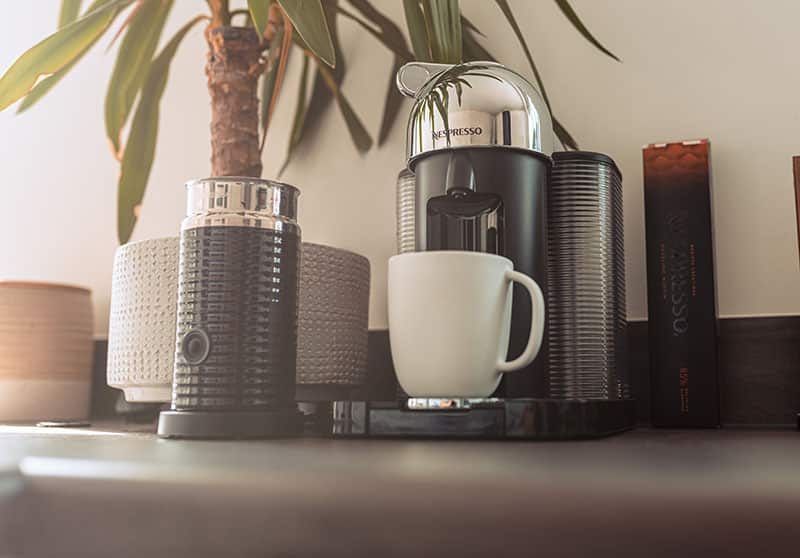Owning an electric milk frother can be like owning a cat. It’s temperamental, and it will sometimes work and be very affectionate. The rest of the time, it just sits there like it’s plotting the murder of the rest of your coffee machine family.
Sometimes, your Nespresso frother needs extra care and attention when it breaks down. If you notice that your Nespresso milk frother isn’t frothing your milk properly, then you’ll need to address that pronto! Particularly if you like to make lattes or enjoy frothed milk on your cappuccinos. Or, if you make a London Fog – earl grey tea + frothed hot milk!
Why Is My Nespresso Frother Not Working?

There are a few reasons why your Nespresso frother isn’t functioning anymore. Shall I list the ways? Yes, yes I shall. But before we proceed, our troubleshooting guide is for electric milk frothing machines. The manual frothers rarely break – and if they do, it’s usually a part that can be replaced. Manual frothing machines are much simpler!
Now, let’s get to diagnosing your Nespresso frothing issues (this guide should help you troubleshoot almost any electric milk frother, including non-Nespresso products).
Dirt On the Electrical Contacts
One of the most common problems with Nespresso frothers is that they collect dirt, dust and grime like the top of a disused fan. The Nespresso Aeroccino frother is powered by connectors on the bottom of the device.
Sometimes, the female connector and other electrical components accrue dirt and traces of milk residue. This can cause your electrical contacts not to fire correctly. You might have this problem if your machine fails to start when you press the button or unexpectedly stops during a frothing cycle.
Dirt on the electrical contacts causes a short between the wire and the heating element. You can fix this easily by cleaning the hot plate (and its male plug and female connector) and good wipe down with hot water and contact cleaner. Make sure your machine is turned off before you attempt any cleaning procedures.
Broken Magnetic Whisk
Most electric milk frothers operate by magnetic whisk. This small magnetic device is magnetically placed in the bottom of your machine and is drive by a small motor beneath that causes it to churn when the machine is turned on.
Sometimes, the malfunction with your milk frother can be that you have a broken magnetic whisk. On the bottom of your magnetic whisk, there’s a small magnet, known as neodymium magnet – a permanent magnet made from iron – that’s used in the construction of your machine. This magnet sometimes gets lost or dislodges from the whisk.
Given that these are supposed to be permanent magnets, them becoming dislodged is usually a sign that your magnet is worn out and you’ll need to buy a replacement.
These magnets aren’t very expensive and can be purchased through Amazon.
Replacement Magnetic Whisk
Gunk On the Magnetic Whisk
Another possible issue with your magnetic could be that it has accrued too much gunk from constant use. Particularly if you’re frothing your milk every day and then not rinsing it off thoroughly afterwards, you’ll likely have milk residue on your whisk.
Too much milk residue means that your whisk won’t function properly. A simple clean is to wash it with hot water and soap and use a small bristle brush to get in between the different parts to get all of that residue off.
A Burnt-Out Heating Element
A burnt-out heating element is one of the worst things that can happen to your Nespresso frother! This isn’t an easy fix and will unfortunately mean your frother is KIA. Most frothers use copper as a heating element and they sit atop a printed circuit board. The electrical current causes the copper to heat up, which warms the milk as the magnetic whisk does its thing.
This is an advanced fix for folks who are competent with electrical wiring. If this isn’t you, then don’t do it! You’ll need to solder a small piece over where your track (there are rings of copper laid over the PCB) is burned out. This will require a soldering iron and some technical skills.
Again, we don’t recommend doing this unless you are comfortable working with electrics. You should call in a professional or replace your frother if you are even a bit uneasy.
A Damaged Thermocouple
A thermocouple is the device that’s located inside the frother’s electronic components and relays temperature readings to tell the frother when to turn on and off – when the desired temperature is reached. Usually, this will range from 140F to 155F.
Thermocouple damage isn’t easy to repair – again, it’s an advanced fix for someone who knows what they’re doing when it comes to electrics. Anything less than full competency and it should not be attempted. You’re seriously better off to replace the thing entirely.
This damaged thermocouple is usually a result of normal wear and tear.
Too Much Milk
Another reason for a malfunction in your frother is that there’s too much milk in the machine. Most milk frothers will have measurement indicator lines for the ideal amount of milk for a specific beverage. Overfilling your milk could result in spillage – which may be dangerous for your electrical components!
Be careful to follow the measurements correctly and don’t fill your machine to its maximum capacity too often. Be particularly careful if you’re watering your milk down with cold water.
Unsuitable Type of Milk

We all know that there are many different types of milk out there. Those with dairy allergies often elect to use soy, almond, or oat milk in their quest to find a non-dairy alternative. While there isn’t necessarily an ‘unsuitable’ type of milk for your frothing desires, there are different milks that will make your life harder when it comes to maintaining the cleanliness of your milk frother.
Here are the most suitable milks for your frothing freakishness!
- Oat milk
- Cashew milk
- Goat’s milk
- Whole milk
Unfortunately, for those who love 2% milk, almond milk, soy milk, coconut milk, or cow’s milk, you will be busy cleaning your frother more often. This is because they lack the proteins and fat content to produce the frothed milk product you’re used to.
How To Effectively Clean Your Milk Frother
There are a few methods to clean your milk frother and make a fantastic cup of coffee with frothed milk.
- Remove and clean your magnetic frothing component with a damp cloth and hot, soapy water.
- Next is to clean the milk container itself. You’ll need alkaline and acid cleaners if you frequently use dairy milk. You can find both types of cleaners on Amazon, and below is our recommendation.
Alkaline-based cleaner
- We recommend using one acid clean for every four alkaline cleans. Follow the steps provided by Urnex.
Luckily for those with milk frothers, there’s not much to them – so a thorough clean should take about 10 minutes. You can blend your frother clean into your regular nightly dishes so that it’s dry and ready for use the next morning.
Nespresso Aeroccino Troubleshooting
If your Nespresso Aeroccino begins to have a blinking red light on the center button, this is likely because it is overheating. This happens when there has been damage to the heat transfer system, likely due to milk overflow or excess milk residue.
If you’re having an electrical issue, check the circuit breaker to see if the Nespresso is tripping your breaker. To see if you have a faulty outlet, plug something else into the same outlet as your frother. If that doesn’t work, then the problem may be with your power station.
If you’re having multiple issues with your milk canister, or other parts of your milk frother – or your motor has burned out – it may be time to replace the frother entirely. It’s best to contact Nespresso customer support and see what they recommend.
How to Reset Nespresso Milk Frother
If you’re having an electrical issue with your machine that hasn’t been repaired by following our above steps, you can try resetting your Nespresso frother as a final option. How you do this largely depends on your model – but for the Nespresso Barista Milk Frother, you’ll want to press the two arrows on the front of the frother simultaneously for three seconds. Then, press the center button to conduct a factory reset.
This will reset all of your Nespresso frother’s settings, but also fix any programming errors. This is a last resort method before replacing your machine entirely.
Final Thoughts
Nespresso is a fine maker of milk frothers. Some coffee machines (mostly commercial models) have built-in frothers. These may have a descaling mode that uses a descaling solution made of mild detergent to clean the frother.


![Urnex Rinza Alkaline Formula Milk Frother Cleaner - 33.6 Ounce [Over 30 Uses] - Breaks Down Milk Protein Fat and Calcium Build Up Cycles Through Auto Frother Cleans Lines Steam Wands & Steel Pitch...](https://m.media-amazon.com/images/I/31z++IYjHoL._SL500_.jpg)
